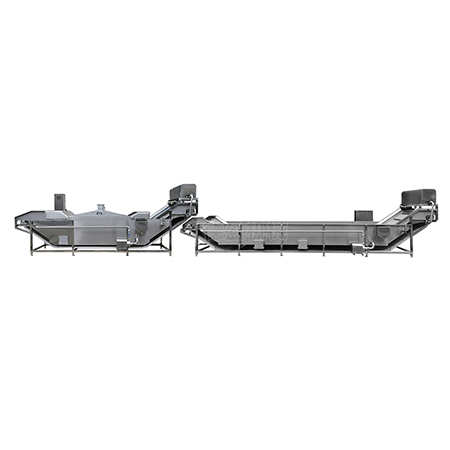Vegetable Blanching Machine
Vegetable Blanching Machine
Blog Article

vegetable blanching machine is used for rapid blanching of vegetables, with a common output of 300kg/h-5t/h, suitable for leafy vegetables, root vegetables, beans, etc. The temperature is adjustable from 80-100℃, and the heating methods include steam, electricity, and gas. It is equipped with a water cooling or air cooling system, and is made of 304 stainless steel, which is durable and easy to clean, and is widely used in the food processing industry.
Vegetable Blanching Machine is a kind of equipment used in the food processing industry, mainly used for blanching (scalding) of vegetables, fruits, beans, and root products. The equipment can effectively inactivate enzymes, maintain vegetable color, and improve texture by heating at high temperature for a short time, while preparing for subsequent quick freezing, dehydration, drying or canning.
Output
The processing capacity of vegetable blanching machines varies depending on the model and design, and the general output range is 300kg/h to 5t/h. For example, small equipment can process 300-500kg/h, medium-sized equipment can reach 1-2t/h, and large industrial production lines can reach 3-5t/h or even higher.
Scope of application
Applicable to a variety of vegetables, including:
Leafy vegetables: spinach, celery, cabbage, pea sprouts, etc.
Root vegetables: carrots, potatoes, sweet potatoes, lotus roots, etc.
Beans: green beans, edamame, French beans, peas, etc.
Cauliflower: cauliflower, broccoli, etc.
Blanching temperature control
The temperature control range is generally 80-100℃, which can be accurately adjusted by the PLC intelligent control system, with an error range of ±1℃ to meet the processing needs of different foods. The blanching time is usually between 30 seconds and 5 minutes, which can be adjusted to suit the characteristics of different vegetables.
Heating method
The equipment can choose the following heating methods:
Steam heating (common in large production lines, fast heating speed, high thermal efficiency)
Electric heating (suitable for small production, stable temperature, suitable for enterprises with low energy consumption requirements)
Gas heating (suitable for factories without steam boilers, low cost)
Pre-cooling and cooling function
Quick cooling is usually required after blanching to avoid overcooking of vegetables and maintain taste and color. Cooling methods include:
Normal water cooling (suitable for less sensitive vegetables)
Ice water cooling (0-5℃, suitable for quick-frozen vegetables)
Combination of air cooling + water cooling (suitable for temperature-sensitive products such as leafy greens)
Material and quality
Food-grade stainless steel (304 stainless steel, 316 stainless steel is optional for some high-demand food production)
Conveyor mesh belt: SUS304 stainless steel mesh belt or food-grade polypropylene (PP) plastic mesh belt, high temperature resistant and easy to clean
Insulation layer: The equipment is usually equipped with an insulation layer to reduce energy consumption and improve heating efficiency
Drainage and cleaning design: Equipped with an automatic drainage system for easy cleaning and maintenance
Vegetable blanching machines are widely used in industries such as quick-frozen foods, dehydrated vegetables, canned food processing, and prepared foods. Its high efficiency, energy saving, and easy maintenance make it an ideal choice for modern food processing companies.
FAQ
How to cool after blanching?
Equipped with normal temperature water cooling, ice water cooling (0-5℃) or air cooling + water cooling to ensure that vegetables cool down quickly and maintain color and taste.
What is the material of the equipment? Is it durable?
The main body is made of food-grade 304 stainless steel (optional 316 stainless steel), and the conveyor belt is SUS304 or food-grade plastic, which is resistant to high temperature, corrosion-resistant and easy to clean.
Will blanching destroy the nutrition of vegetables?
Proper blanching can kill enzymes, prevent browning, lock in nutrients, and reduce processing losses without destroying the nutritional value of vegetables.
Is the equipment easy to clean and maintain?
Designed with automatic drainage system and easy-to-remove parts, it is easy to clean, with low maintenance cost, and can ensure food safety and hygiene.
Does it support customization?
Support customized output, size, temperature control system, conveyor belt material, etc. to adapt to different production line requirements.
How is the equipment warranty and after-sales service?
The warranty is usually 1-2 years, and we provide installation, commissioning, training services, and long-term supply of accessories to ensure stable operation of the equipment. Report this page